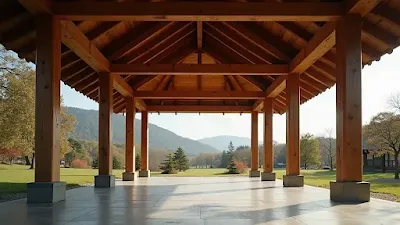Creating an inviting and functional outdoor space can greatly enhance your home’s enjoyment and overall value. A well-designed pavillon wood structure serves as a charming feature that not only provides a sheltered area for relaxation and entertainment but also enriches the aesthetic appeal of your detached yard. By mastering the geometric principles behind pavillon design, you can simplify the construction process and achieve a stunning transformation that seamlessly integrates with your home.
Understanding the Basics of Pavillon Structures
A pavillon typically comprises a framework of posts and beams, forming a sturdy and visually pleasing structure. The roof can be flat or sloped, contributing to both its functionality and aesthetic value. The geometry involved is essential for stability and longevity. For example, when constructing a 12-foot by 12-foot pavillon, ensuring proper angles and load distribution during design is crucial to withstand weather conditions, such as heavy rain or strong winds.
The posts, serving as vertical supports, are usually anchored securely to the ground, while the beams act as horizontal supports that transfer the weight from the roof to the posts. Understanding how to connect these key elements while considering overall shape is vital for a successful build.
The Geometry of Posts and Beams
The Role of Posts
Posts are often square or rectangular and serve as the primary vertical supports for the pavillon. The dimensions of these posts determine their load-bearing capacity. For instance, a standard 6x6 cedar post can support up to 1,000 pounds when properly installed.
Choosing materials wisely is essential; cedar is a favorite due to its natural resistance to decay and pests. Each post should be set deeply into the ground, roughly one-third of its height, ensuring stability against wind and weather.
Beam Configuration
The beams are just as important, connecting two or more posts and forming the structural framework. Selecting the right type of beam is critical. For example, a rectangular beam is typically used for a flat roof, while an I-beam configuration might be necessary for a sloped roof to enhance strength and load capacity.
For a pavillon with a sloped roof, you might use beams measuring 2x8 inches, angled to promote water runoff. These considerations ensure that your structure is not just beautiful but also stable.
Image Placeholder 1:
Bonding the Structure
The connection between posts and beams is pivotal. Traditional joints like mortise and tenon or lap joints provide strength and allow some flexibility to adapt to environmental stresses. Understanding angles, load distribution, and the materials used is fundamental for a robust construction. Professional carpenters often use tools such as pocket hole jigs for precise fitting, ensuring durability.
The Roof Design: A Geometry-Driven Approach
The roof shape is not just an aesthetic choice; it also impacts functionality. Popular roof types include gabled, hipped, and flat, each affecting water drainage and structural stability.
For instance, a gabled roof, characterized by its two sloping sides, effectively directs water away, minimizing mold growth and decay. If you choose a flat roof, it's vital to incorporate a slight slope to facilitate drainage. Data shows that structures with adequate slopes have up to 30% less water-related damage compared to those without.
Image Placeholder 2:
Practical Considerations for Building a Pavillon
When planning your pavillon wood structure, keep several key factors in mind:
Local Regulations
Check your local building codes and regulations regarding outdoor structures. Permits are essential to comply with safety standards and avoid future complications. In some neighborhoods, permits for structures larger than 150 square feet may be required.
Material Selection
Opt for high-quality, weather-resistant timber that aligns with your design vision and budget. For example, pressure-treated pine can offer good longevity at a lower cost, while using hardwoods like mahogany or teak can provide exceptional durability but at a higher price point.
Functionality and Use
Think about how you will use the pavillon. Will it be a tranquil reading nook, an entertainment area, or a workspace? This understanding will influence its size and shape, as well as what amenities you might want (e.g., lighting, built-in seating, or landscaping features).
Image Placeholder 3:
Final Thoughts
Constructing a pavillon wood structure goes beyond mere assembly; it requires a solid grasp of geometry and design principles. By thoughtfully considering posts, beams, and roof shapes, your pavillon can be both a beautiful centerpiece and a practical addition to your outdoor space. Whether you are a professional carpenter or a homeowner embarking on your first project, understanding the geometry involved will greatly enhance your outcomes.
With the right guidance and knowledge, you can create a stunning outdoor structure that enriches your home life and becomes a cherished gathering place for years to come.



No comments:
Post a Comment